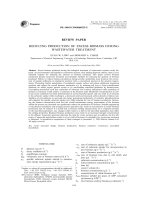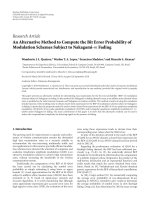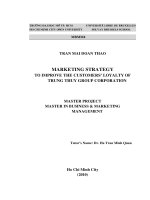Modification of sand with fe zn oxides an alternative strategy to improve adsorption of phosphate from artificial wastewater treatment
Bạn đang xem bản rút gọn của tài liệu. Xem và tải ngay bản đầy đủ của tài liệu tại đây (6.78 MB, 19 trang )
<span class="text_page_counter">Trang 1</span><div class="page_container" data-page="1">
<small>Full Terms & Conditions of access and use can be found at</small>
<b><small>ISSN: (Print) (Online) Journal homepage: www.tandfonline.com/journals/geac20</small></b>
<b>Modification of sand with Fe-Zn oxides: analternative strategy to improve adsorption ofphosphate from artificial wastewater treatment</b>
<b>Fengbing Tang, Zheng Xu, Yanfei Wang, Yaqian Dang, Simin Li & Zhennan Shi</b>
<b>To cite this article: Fengbing Tang, Zheng Xu, Yanfei Wang, Yaqian Dang, Simin Li & Zhennan</b>Shi (19 Mar 2023): Modification of sand with Fe-Zn oxides: an alternative strategy to improve adsorption of phosphate from artificial wastewater treatment, International Journal of Environmental Analytical Chemistry, DOI: 10.1080/03067319.2023.2190459
<b>To link to this article: online: 19 Mar 2023.</small>
<small>Submit your article to this journal </small>
<small>Article views: 50</small>
<small>View related articles </small>
<small>View Crossmark data</small>
</div><span class="text_page_counter">Trang 2</span><div class="page_container" data-page="2"><b>Modification of sand with Fe-Zn oxides: an alternative strategy to improve adsorption of phosphate from artificial wastewater treatment</b>
Fengbing Tang<small>a,b</small>, Zheng Xu<small>b</small>, Yanfei Wang<small>b</small>, Yaqian Dang<small>b</small>, Simin Li<small>b </small> and Zhennan Shi<small>b</small>
<small>aHebei Key Laboratory of Intelligent Water Conservancy, School of Water Conservancy and Hydroelectric Power, Hebei University of Engineering, Handan, China; bHebei Engineering Research Center for Sewage Treatment and Resource Utilization, Hebei Technology Innovation Center of Water Pollution Control and Water Ecological Remediation, Handan Key Laboratory of Urban Water Utilization Technology, Hebei University of Engineering, Handan, China</small>
<small>In this work, Fe-decorated quartz sand (FS), Fe-Mn bimetallic cation- decorated quartz sand (FMS) and Fe-Zn bimetallic cation-decorated quartz sand (FZS) were synthesised from ordinary quartz sand (QS). Iron, iron-manganese and iron-zinc oxides were stably formed on the surfaces of FS, FMS and FZS, respectively. The specific surface area of FZS (1.0497 m</small><sup>2</sup><small>/g) increased to more than 320% against that of QS (0.2482 m</small><sup>2</sup><small>/g). The obtained samples were evaluated for the removal of phosphate from artificial wastewater. Parameters that can affect adsorption process include solution phosphate concen-tration, pH and retention time, which were investigated by bath adsorption experiments. Under the optimal experimental condi-tions (pH value 4.0, initial concentration of phosphate 15 mg/l, temperature 25°C, retention time 150 min and adsorbent dose 5 g), the removal efficiency of phosphate by FS was higher than that of QS, FS and FMS and the maximum phosphate adsorption capa-city (qmax) provided by FZS is 0.18 mg/g. Furthermore, the kinetics of phosphate adsorption fit well with the pseudo-second-order model, indicating that adsorption of phosphate on the Fe-Zn co- decorated quartz sand occurred through chemisorption, and the Langmuir adsorption isotherm model (R</small><sup>2 </sup><small>= 9944) is more suitable for adsorption capacity prediction than the Freundlich adsorption isotherm model (R</small><sup>2 </sup><small>= 0.9427). The results show that quartz sand can be modified effectively, which has great practical application potential in water treatment.</small>
Water is a precious resource required for the survival of human beings and other lives although there are abundant freshwater resources worldwide and only less than 0.3% is available for human use [1]. With the vigorous development of industry and agriculture, the water ecological environment has been seriously damaged. Phosphate in inade-quately treated wastewater could decline the water quality, and high phosphate levels
<b><small>CONTACT </small></b><small>Simin Li ; Zhennan Shi </small>
</div><span class="text_page_counter">Trang 3</span><div class="page_container" data-page="3">can lead to eutrophication of water body [2–4]. Thus, there is significant interest in different methods for the effective phosphate removal from wastewater. Various techni-ques have been adopted to remove phosphate from wastewater, including chemical precipitation, biological treatment, membrane separation and adsorption methods [5– 8]. Nevertheless, there are limits to these approaches. Chemical precipitation might produce supplementary pollution by introducing a new class of hazardous, biodegrada-tion dephosphorisabiodegrada-tion, which usually suffers from a long working period and strict conditions; the cost of membrane treatment technology is uneconomical and requires high maintenance requirements [9]. Instead, adsorption methods require material cap-able of strong physical and chemical adsorption between the surface of the material and phosphate to remove phosphate from wastewater [10]. Moreover, adsorption methods have advantages of high efficiency, wide adaptability and easy operation and produce no secondary pollution, so this phosphate removal method is regarded as a reliable and easy to operate treatment technique [11]. Since superior adsorbents could significantly increase adsorption efficiency, it is critical to develop an efficient and environmentally friendly adsorbent for the effective removal of phosphate contaminants.
Quartz sand is a natural stable mineral that is generally used as a filter material in wastewater treatment process [12–14]. Although natural sorbents are satisfactory from the standpoint of being environmentally friendly, most natural materials have only low ability to remove phosphate from wastewater, far below that required for practical applications. Studies have proven that metallic cations have powerful affinity for phos-phate, which is mainly due to the typically electrostatic or ionic interactions between the metal coatings and phosphate [15,16]. Previous studies have shown that modifying quartz sand with metal ions is an effective strategy to develop the adsorbent for phosphate removal from water, and there is particular interest in the use of metal ions for substrate modification due to the high affinity of metal ions for phosphate concluded the efficiency of adsorption of phosphate is increased after iron and aluminium oxides modifying the quartz particles [17]. There is attraction between phosphate ions and metal ions with the formation of various metal phosphates, such as iron phosphates (Fe-P), aluminium phosphates (Al-P) or calcium phosphates (Ca-P) [18]. Iron ions have been extensively used as strong sorbents for phosphate; however, iron oxide is a kind of loose and amorphous flocculating material that is easy to hydrolyse, leading to poor water con-ductivity, and it is difficult to dehydrate, for low overall phosphate removal efficiency [19,20]. Therefore, there is a significant need for an effective method to modify sorbents for improved adsorption of phosphate. Zinc has been tested as a modification agent, which could be partly transformed into Zn<sub>3</sub>(PO<sub>4</sub>)<sub>2 </sub>precipitation in the presence of phos-phate, with significant differences in phosphate removal in the presence and absence of Zn cation [21]. Based on the demonstrated ability of Zn and Fe modification to improve phosphate adsorption, in this study, Zn and Fe cations were introduced into an adsorp-tion system to construct bimetallic caadsorp-tion-modified quartz sand.
Fe-Zn co-modified quartz sand was prepared and tested for phosphate adsorption. The properties of this material were characterised and compared to those of quartz sand, Fe oxide-decorated quartz sand and Fe-Mn co-decorated quartz sand. The specific surface area of FZS (1.0497 m<sup>2</sup>/g) increased to more than 320% against that of QS (0.2482 m<sup>2</sup>/g). The practical application of the prepared substrates for phosphate removal from wastewater was evaluated under static conditions. The phosphate
</div><span class="text_page_counter">Trang 4</span><div class="page_container" data-page="4">removal from aqueous solutions was measured with varying pH value, initial concen-tration and retention time, allowing determination of adsorption kinetics and iso-therms, indicating that adsorption of phosphate on the Fe-Zn co-decorated quartz sand occurred through chemisorption and the Langmuir adsorption isotherm model (R<sup>2 </sup>= 9944) is more suitable for adsorption capacity prediction than the Freundlich adsorption isotherm model (R<sup>2 </sup>= 0.9427). Fe-Zn co-modified quartz sand exhibits a maximum phosphate adsorption capacity (q<small>max</small>) of 0.18 mg/g. Finally, based on the above results, possible mechanisms for phosphate removal of this new material is proposed.
<b>2. Materials and methods</b>
<i><b>2.1. Wastewater sampling and analysed method</b></i>
The experimental wastewater used in this study is manually configured as waste-water. The phosphate (PO<small>4</small><sup>3-</sup>) concentrations in water was configured through 50 mg/ L KH<small>2</small>PO<small>4 </small>standard solution, and the effect of co-ions on the removal of phosphate is negligible. The pH of the solution was adjusted using HCl and NaOH. All the reagents used in this study were of analytical grade and were used without further purifica-tion. In the adsorption experiment, the residual phosphate concentrations were
<i>analysed through ammonium molybdate spectrophotometry (Water quality- </i>
<i>Determination of total phosphate-Ammonium molybdate spectrophotometric method, GB 11,893–89[S]) using a UV–visible spectrophotometer (6600UV-VIS) at a wavelength </i>
of 700 nm.
<i><b>2.2. Preparation of modified quartz sand for different metal cations</b></i>
Pristine quartz sand, sized 0.8–1.2 mm, which was used as filter medium in the experi-ments, was derived from the V-type filter of the deep treatment unit in the sewage treatment plant. The fabrication process of modified quartz sand was performed according to the following typical process, briefly, a 50 g sample of quartz sand was washed with distilled water two times to remove any surface-adhered particles, soaked in 30 mL acetone solution for 24 h to remove any dissolvable organic ion on the sand surface, rinsed several times in ultrapure water and then dried at 110°C for 2 h. The resulting dried quartz sand sample was transferred into 20 mL mixed solution which contained FeCl<small>3 </small>10 mL and ZnSO<small>4 </small>10 mL present at molarities of 2.67 mol/L and 0.33 mol/L, respectively. Next, 2 mL of 5 mol/L NaOH was added dropwise to the solution by stirring for 5 min. The sample of quartz sand was dried at 120°C for 12 h, the as-obtained Fe-Zn oxides co-modified quartz sand was rinsed with deionised water several times and then dried at 60°C and the oxides co-modified quartz sand was named as FZS. For comparison, Fe-Mn co-modified quartz sand was prepared as above process; using MnCl<small>2 </small>in place of ZnSO<small>4.</small>, the resulting material was designated as FMS. Fe-modified quartz sand which was modified by single FeCl<small>3 </small>solution in place of mixed solution containing FeCl<small>3 </small>and ZnSO<small>4 </small>was named FS. And pristine quartz sand without any modification methods was named as QS.
</div><span class="text_page_counter">Trang 5</span><div class="page_container" data-page="5"><i><b>2.3. Material characterisation</b></i>
Scanning electron microscopy (SEM, Hitachi, SU-8200, Japan) was used to investi-gate the surface morphologies of the samples. X-ray diffractometer (XRD, D/Max- 2200, Japan) analysis was performed to examine the structures of the samples. The X-ray photoelectron spectroscopy (XPS) examination was done using VG-ESCALAB LKII instrument armed with an Mg Kα X-ray source (hv = 1.2356 keV), which was used to further observe the chemical composition of the obtained samples. Specific surface area and pore structure analyser (BET, TRISTAR II 3020, American) was used to characterise changes in the surface structure of quartz sand. The Fourier Transform infrared spectrometer (FTIR, Nicolet, Avatar 370, American) was used to characterise changes in the surface composition of quartz sand.
<i><b>2.4. Batch adsorption experiments</b></i>
Phosphate adsorption experiments of composites were carried out using 100 mL KH<small>2</small>PO<small>4 </small>solution (10 mg/L), with seven initial concentrations of phosphate: 1, 2.5, 5, 10, 15, 25 and 50 mg/L. Sampling was performed after certain intervals. The reactions were performed in Erlenmeyer flasks sealed with plastic wrap and shaken in a mechanical orbit shaker at a rotation speed of 150 rpm. Samples were filtered immediately after being withdrawn from the solution using a 0.45-µm polycarbo-nate filter membrane. The residual phosphate concentrations were analysed. All adsorption experiments were performed in triplicate, and the average of the experimental results was used as valid data.
Adsorption kinetics are represented by pseudo-first-order and pseudo-second-order (Equation 1 and 2) models [22]. where t represents the adsorption time, q<sub>t </sub>is related to the adsorption capacities at time t, k<small>1 </small>and k<small>2 </small>are constants and q<small>e </small>is the equilibrium adsorption.
Adsorption behaviour with various initial pH values (1, 3, 5, 7, 9 and 11) were conducted and 100 mL solutions with an initial phosphate concentration of 15 mgL<small>−1</small>. The adsorption kinetics of phosphate are calculated according to the Langmuir and Freundlich isotherm models, which are presented by the following
</div><span class="text_page_counter">Trang 6</span><div class="page_container" data-page="6"><i><b>2.5. Effect of pH</b></i>
The pH of suspension was pre-adjusted from 1 to 11 with small amounts of NaOH or HCl solution. Five-gram adsorbent and 100 mL of phosphate solutions (15 mg/L) were added to the 250 mL conical flasks with various initial pH values. The flasks were agitated on a standard analogue shaker with a speed of 165 rpm at 25°C, and then the terminal pH values of the solutions were immediately measured before the supernatant sample was taken to measure the residual phosphate concentration and to analyse the effect of pH on phosphate adsorption efficiency.
<b>3. Results and discussion</b>
<i><b>3.1. Scanning electron microscope (SEM) analysis</b></i>
The morphological characterisation is used to detect the detailed information about the quartz sand surface changes in surface morphology resulting from the modification; SEM images of QS, FS, FMS and FZS were analysed as presented in Figure 1. As shown in
Figure 1(a), the quartz sand (QS) exhibited a relative smooth surface without secondary structures. However, after Fe oxide modification, as shown in Figure 1(b), the QS surface was no longer smooth but was decorated with numerous secondary prominences. The surface of QS appeared rough after Fe-Mn oxide-modification, as shown in Figure 1(c); the SEM image of FMS reveals a surface of quartz sand that is covered by the shaggy flocculent shape of Fe-Mn oxides. The SEM image of FZS is shown in Figure 1(d) and shows the uniform dispersion of a great number of tetragonal prisms with very rough surfaces on the quartz sand surface, with microprisms fully covered by numerous nano-needle arrays interweaving with each other for highly open and porous nanostructures. This unique structure would greatly improve the specific surface area of the FZS, and the open micro-nanostructure could provide numerous active surface groups for increased phosphate adsorption removal efficiency. The process route for the preparation of Fe-Zn bimetallic cation-decorated quartz sand is shown in Figure 1(e).
<i><b>3.2. Brunauer – Emmett–Teller (BET) analysis</b></i>
The physical and structural characteristics of the quartz sand material surface were characterised by measuring the specific surface area (BET), as the specific surface area of the filter material reflects the adsorption capacity. Specific surface area measurements were determined for QS, FS, FMS and FZS, and the changes in surface area of the modified materials compared to that of QS are shown in Figure 2.
As shown in Figure 2, the specific surface areas of QS, FS, FMS and FZS were deter-mined as 0.2482 m<sup>2</sup>/g, 0.3338 m<sup>2</sup>/g, 0.9189 m<sup>2</sup>/g and 1.0497 m<sup>2</sup>/g, respectively. With minimal specific surface area, the QS exhibits low adsorption performance on phosphate removal. In FS, the roughness of the quartz sand surface was increased by loading a layer of iron oxide, causing an increase in the surface area (0.3338 m<sup>2</sup>/g) of 34.49%. Compared with the single iron oxide layer structure on the surface of FS, iron-manganese (FMS) and iron-zinc (FMS), two metal modification methods formed more complex structure with the loading of the composite oxide layer, and this structure greatly increased the roughness of the sand surface. The FMS specific surface area increased to 270% that of QS, and to our
</div><span class="text_page_counter">Trang 7</span><div class="page_container" data-page="7">surprise, that of FZS increased to more than 320% that of QS. These large increases in specific surface area are conducive to improved adsorption of pollutants.
<i><b>3.3. X-ray diffraction (XRD) analysis</b></i>
The XRD patterns of samples were determined and are exhibited in Figure 3. There were sharp diffraction at 20.70, 26.70, 36.58, 39.56, 42.50, 50.16, 55.14, 60.02 and 68.28 due to the presence of silica in all samples. The XRD pattern of QS is consistent with the previously published literature [14,24]. Comparison of the XRD patterns of various samples reveals similarities. Interestingly, the angles for uncoated sand (QS) slightly shifted higher when sand was coated with oxide (FS, FMS and FZS). Previous work reported diminishing intensity when the oxides covering the sand grain were amorphous, thus decreasing the crystallinity of the sand [25]. In our system, the invariability in the intensity of diffraction peak implies
<b>Figure 1. </b>SEM images for QS (a), FS (b), FMS (c) and FZS (d), Fabrication route for Fe-Zn bimetallic cation-decorated quartz sand (e).
</div><span class="text_page_counter">Trang 8</span><div class="page_container" data-page="8">a high crystallinity of oxides. However, the XRD signal of metal oxides is faint, such as the faint diffraction peak at 27.5° belonging to γ-Fe<sub>2</sub>O<sub>3 </sub>[26], suggesting that there may be inhibition of oxide crystallisation or that the oxide nucleated as nanometre particles that are not detectable by XRD [27].
<b>Figure 2. </b>Relative specific surface area of QS, FS, FMS and FZS.
<b>Figure 3. </b>XRD patterns of QS, FS, FMS and FZS.
</div><span class="text_page_counter">Trang 9</span><div class="page_container" data-page="9"><i><b>3.4. X-ray photoelectron spectroscopy (XPS) analysis</b></i>
To further understand more about the chemical composition and purity of the oxide layer on the obtained materials surface, the samples were next subjected to XPS analysis, and the results are shown in Figure 4.
The wide scan (Figure 4(a)) shows the presence of elements silicon, oxygen and carbon in pristine QS and the presence of element Fe in FS, FMS and FZS. The element Mn was also detected in FMS and element Zn was detected in FZS. The C element is generally accepted as an adventitious carbon-based contaminant, and the binding energy for C 1s peak at 284.6 eV was used as a reference for calibration. The O 1s shown in Figure 4(b) is composed of two kinds of peaks, the peak located at 529.3 eV corresponds to the metal- oxygen bonds in the form of O<sup>2−</sup>, which is characteristic of the oxygen in metallic oxides, while the peaks located at 533.1 eV are in accordance with the presence of OH−. The Si 2p spectrum for FMS and FZS is shown in Figure 4(c), which could be deconvoluted into two peaks at 102.7 and 100.5 eV; the minor intensity at 100.5 eV is attributed to the appear-ance of metal-O-Si bond types that has been previously reported [28,29]. Figure 4(d)
shows the Fe 2p core-level spectrum, and the peaks at binding energies of 711.3 and 724.4 eV appeared in the FMS and FZS were assigned to Fe 2p3/2 and Fe 2p1/2 energy levels, respectively, which are typical signal of Fe<sup>3+ </sup>ions. The spectra with peaks position and line shapes are consistent with those reported values for Fe<small>2</small>O<small>3 </small>[30]. Therefore, the analysis confirmed the existence of Fe<small>2</small>O<small>3 </small>FMS and FZS. The Mn 2p3/2 peak observed at 641.9 eV with a distance of 11.4 eV to the Mn 2p1/2 peak, indicating that the valence state of Mn underwent+3 and+4, with Mn<sup>4+ </sup>dominant based on the Mn 2p3/2 peaks [31]. This result confirms manganese oxide phase in FMS that is separate from iron oxide; similarly, the high-resolution Zn 2p spectrum (Figure 4(f)) can be deconvoluted into two spin-orbit
<b>Figure 4. </b>(a) XPS survey scan of QS, FS, FMS and FZS, XPS spectra of O1s (b), Si 2p (c) and Fe 2p (d) for FMS and FZS, (e) XPS spectra of Mn 2p for FMS and (f) XPS spectra of Zn 2p for FZS.
</div><span class="text_page_counter">Trang 10</span><div class="page_container" data-page="10">doublets. The two main peaks located at 1021.9 and 1044.9 eV are related to Zn 2p3/2 and Zn 2p1/2, suggesting the existence a normal state of Zn<sup>2+ </sup>[32]. Thus, the XPS study confirms that Fe-Mn oxides co-existed in FMS and Fe-Zn oxides co-existed in FZS.
<i><b>3.5. Fourier transform infrared spectrum (FTIR) analysis</b></i>
To characterise the changes of metal oxidation layer composition on the samples surface, QS, FS, FMS and FZS were analysed by Fourier transform infrared spectroscopy, and the pictures of FTIR spectral are shown in Figure 5.
As shown in Figure 5, QS has an absorption peak from 1000 to 1250 cm<small>−1 </small>represented by longitudinal and transverse symmetric contraction vibration of Si-O-Si and a silicon hydroxyl vibration peak represented by Si-Si-O stretching vibration from 3200 to 3600 cm<sup>−1 </sup>[33]. FS has a representative Fe-O vibration absorption peak at 505.35 cm<sup>−1</sup>, demon-strating that iron oxide has coated the quartz sand surface. The absorption band of FMS
<b>Figure 5. </b>Fourier transform infrared spectrums of different quartz sand.
</div>








